This post has been republished with author permission. The original post, published by HudsonAlpha, is available here.
Pears are big business in the United States’ Pacific Northwest. But did you know that traditional pear breeding has remained largely unchanged for centuries? This slow process is difficult and costly, requiring the long-term commitment of labor, materials, and land-space resources. However, traditional pear breeding might get some help from genomics, thanks to a unique collaboration between students, scientists, and the pear industry fostered through an initiative called the American Campus Tree Genomes (ACTG) Project.
ACTG was born from two professors’ desire to memorialize Auburn University’s iconic Toomer’s Oak trees that were poisoned during the 2010 Auburn University football season. Their plan: sequence the oak’s DNA and create the first-ever live-oak reference genome. To sweeten the pot, they decided to create a semester-long course so that actual Auburn students could take part in sequencing the Auburn oak trees.
“ACTG leverages iconic and economically valuable trees to bridge the gap between students and cutting-edge genomics,” says ACTG co-founder Alex Harkess, PhD. “Students collaboratively assemble, analyze, and publish tree genomes in prestigious journals, gaining invaluable experience.”
The first semester was a success despite most of the students having never written a manuscript, performed command line bioinformatics, or engaged in plant genomics molecular work. It sparked a nationwide initiative, which was officially founded in 2021 by Alex Harkess, PhD, Faculty Investigator at HudsonAlpha Institute for Biotechnology, and Les Goertzen, PhD, Director of the John D. Freeman Herbarium at Auburn University. Other institutions can replicate the experience using their own campus trees as a springboard for scientific and educational endeavors.
ACTG is disrupting traditional academic models, offering students a unique entry point into the world of genomic research. The initiative transcends textbook learning, immersing participants in the actual process of assembling, analyzing, and publishing tree genomes in esteemed scientific journals. Students in this course have access to cutting-edge genome sequencing techniques and bioinformatic skills through experts at HudsonAlpha. By working on genuine research projects with tangible outcomes, students gain confidence and experience, shaping their trajectories toward successful careers in the ever-evolving field of genomics.
“This course is a welcoming opportunity for students and trainees to not just interact with a completely new idea but become proficient in it no matter their skill level. I had no previous experience with bioinformatics, and I came out with an entirely new, highly marketable skill set,” says Harrison Estes, an Auburn University ‘23 grad who participated in the pear genome class. He is currently a graduate student at the University of Wisconsin and credits the ACTG class as helping him achieve this goal.
The emphasis on student participation extends beyond technical training. ACTG actively addresses barriers to STEM entry and persistence, providing valuable opportunities for individuals without access to advanced technologies. The ACTG team seeks out participation from small universities and colleges, community and junior colleges, and HBCUs that lack mature genetics and bioinformatics training pipelines.
The transformative power of ACTG goes beyond equipping students with invaluable skills and experience. By delving into real-world research projects, ACTG participants translate their knowledge into tangible applications that directly benefit the scientific community and economically important industries.
In the case of the pear industry, a cohort of Auburn students in the ACTG initiative worked with pear experts at Washington State University and the USDA Agricultural Research Service to create a high-quality pear genome. The meticulous work of the ACTG students yielded a fully phased, chromosome-scale assembly, a significant advancement over previous efforts.
The d’anjou genome assembly, recently published as a featured article in G3: Genes|Genomes|Genetics, reveals thousands of genomic variants which are of great importance to pear breeding efforts. This high-quality resource unlocks a treasure trove of information for pear breeders. The new genome assembly is also an important tool for studies on the evolution, domestication, and molecular breeding of pear.
“The ACTG: American Campus Tree Genomes program not only built high-quality genomic resources for a valuable pear cultivar that will ultimately benefit growers and consumers alike, but it educated nearly 20 students and scientists in the needs of the apple and pear industry,” said Ines Hanrahan, PhD, Executive Director, Washington Tree Fruit Research Commission.
The pear is only one of many important tree species in the ACTG pipeline. Learn more about the American Campus Tree Genomes project here.
References
A chromosome-scale assembly for ‘d’Anjou’ pear
Alan Yocca, Mary Akinyuwa, Nick Bailey, Brannan Cliver, Harrison Estes, Abigail Guillemette, Omar Hasannin, Jennifer Hutchison, Wren Jenkins, Ishveen Kaur, Risheek Rahul Khanna, Madelene Loftin, Lauren Lopes, Erika Moore-Pollard, Oluwakemisola Olofintila, Gideon Oluwaseye Oyebode, Jinesh Patel, Parbati Thapa, Martin Waldinger, Jie Zhang, Qiong Zhang, Leslie Goertzen, Sarah B Carey, Heidi Hargarten, James Mattheis, Huiting Zhang, Teresa Jones, LoriBeth Boston, Jane Grimwood, Stephen Ficklin, Loren Honaas, Alex Harkess
G3 Genes|Genomes|Genetics. March 2024. 14(3).
DOI: 10.1093/g3journal/jkae003




